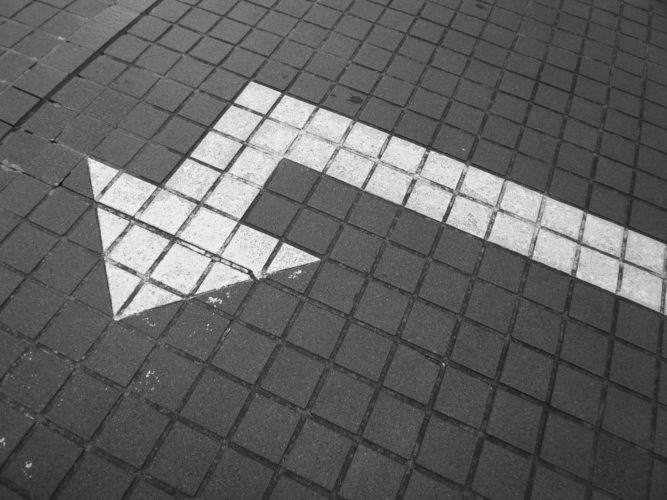This is the last post in a series of three on the topic of triggers. In the first, I talked about identifying triggers. In the second, I talked about what to do with internal triggers.
This post is going to focus on dealing with external triggers and, as promised, there is a downloadable worksheet that boils down this content to help you find and face your own triggers.
Why so much talk about triggers?
In my opinion, understanding what your triggers are is vital in helping you walk in freedom from unwanted sinful behavior.
In the church, we talk a lot about temptation, but I feel temptations are more universal. Triggers are more “customized” and speak to the individual struggle we each may have.
For instance, most people would say a sexually provocative ad on a website is a temptation. It’s not a sin in and of itself but it is definitely a neon sign pointing straight to it.
However, when I talk about one of my triggers being a lotion I had in college, that’s not as much a universal experience. One hundred other people could use that lotion and it has absolutely no connection to pornography for them. That’s because it’s not a temptation; it’s a trigger.
If you look at James 1:14, you’ll see this:
“But each person is tempted when he is lured and enticed by his own desire.” (ESV)
I’ve always found that part “his own desire” fascinating. It’s not “each person is tempted when he is lured and enticed by ads.” No, instead it’s our own desire. That word “desire” in the Greek has also been translated “evil desires.” It is the word epithymias and it means “desire, eagerness for.” It comes from the root word that means “longing.”
So we can look at temptation as the obvious luring of sin. It is sin beckoning our name. A trigger on the other hand, is something that ignites that longing in us. It’s what makes us long for pornography, and the temptation preys on that longing.
Do you see, then, the importance of identifying and dealing with triggers? It’s another way we can disrupt this cycle of sin in our lives.
So let’s talk about what to do with external triggers.
First, they are going to be different for everyone. They could be a sight, smell, even a sensation. A trigger does not have to be sexual at all. It could be completely innocent. It could also be a combination of thing. For instance, having a computer/cell phone might not trigger you, but having headphones to go with that computer/cell phone might trigger you.
Figuring out your own external triggers is going to take some prayer and some detective work. If you’re walking in freedom “for the most part” and find yourself tripped up from time to time, look hard at those times. We don’t like to because we’d rather forget about them, but they can teach us something!
If there wasn’t an emotional element to that fall (look back at internal triggers), then think of the external things that led to it. Where were you? What kind of access did you have? What were the external stimuli? Think back to the process that led you there. At what point did you start thinking about pornography (or lust, masturbation) and start making choices in that direction?
It might be something so small, like a song, or a smell. Or it might be something obvious, like the romantic novel you have stashed under your bed. It might be something good, like a hug from my husband (I’m going to tackle this at the end). And, you can very well have more than one.
The AAA Trigger Trap
(I literally just came up with that title and I’m mildly amused by it).
Typically, when we’re trying to deal with triggers (and not give in to them), we take one of three approaches:
Avoidance, Annihilation, Awareness
But before we address those, it’s very important to address something even deeper. (In case you hadn’t realized it, even dealing with external triggers involves some deep heart work here. Remember, the point is healing, not just “stopping pornography.”)
One of the main questions you need to answer is what is your stance.
Are you navigating your triggers from a place of brokenness or boundaries?
I’m not talking about the healthy, Biblical brokenness but the one shame tries to push on us. If you find yourself saying, “I’m broken and defective and that’s why I have all of these triggers. I’m so messed up,” that’s the wrong voice to listen to.
Are you broken? Absolutely. Is God disappointed in that brokenness? Nope. (Psalm 103:14). Is He up there telling you to hurry up and get your act together? No.
If you try to tackle triggers from a stance of brokenness, this is going to feel a lot less like freedom and a lot more like punishment.
A healthier perspective is to approach this journey from the stance of boundaries. Boundaries give the idea of protecting something good instead of fixing something that is bad. You are figuring out what boundaries you need to protect your journey and to live a life that honors God. They aren’t motivated by fear or shame but instead peace, grace, and self-control.
Keep that in mind as we talk about the AAA Trigger Trap because you can use each of these in a healthy or unhealthy way.
Avoidance
Avoidance is the decision to avoid the trigger altogether. It’s definitely the easiest approach. If I know a lotion makes my mind wander, it’s an easy step to just get rid of the lotion. Done.
And by all means, if you can do that with a trigger, do it. Save your energy and resources for the triggers that aren’t as easy to avoid.
This may mean getting rid of some pieces of tech. It may mean getting rid of some things in your bathroom cabinet or closet. Sure, you can choose to keep it (getting to that), but if you don’t have to, consider getting rid of it.
Remember to do this from a place of boundaries not brokenness. If you do it from a place of brokenness, then you are going to start to miss whatever it is you got rid of. Then, what happens is you start to get triggered by not having the trigger because you miss the trigger and you’re sad you had to get rid of the trigger.
A couple things to know about this: This doesn’t have to be permanent. Boundaries can change over time as you get stronger. There are some things you may always avoid just because it’s easier, but there are some that you can integrate back into your life.
(Example: In my early days of freedom, I was always very triggered by conversations about sex- even healthy ones- so I couldn’t talk about it. Obviously, that’s different now and it doesn’t bother me any more!)
Annihilation
Of the three, this one is the hardest and my least favorite (actually I don’t use this one much). I bring it up, because as Christians we can fall into this trap that we need to “fight” sin.
This is the idea that our triggers shouldn’t even be triggers, so we are going to desensitize ourselves to them. It’s the approach of “I refuse to install accountability software. I refuse block websites. I am going to fight my way through this; I shouldn’t have to have boundaries. I shouldn’t even have triggers.”
Can I just be honest? Most of the time, this approach is flat out unhelpful.
Here’s yet another unpopular opinion, but one that is not uniquely mine:
We’re not called to fight sin in this way.
Sometimes we approach the “fight” with sin like we’re busting into an underground cage fight. We go looking for a fight.
And we believe that victory only comes when we ourselves have delivered a knock out punch to sin and are standing triumphantly with our foot planted firmly on its throat.
Being this is Easter weekend, I think this is a great time to remind you, and remind us all, that we don’t conquer sin.
We are not called to pull up the pornographic website and then click out of the screen as a way to prove we won. We are not called to dance in front of every single temptation we can think of as a way of proving we’re stronger.
That’s not what we’re called to do.
In Proverbs, the advice of wisdom is not to burn down the house of the adulterous woman. The counsel is not to run by the house as quickly as possible. The instruction is to stay as far away from her as possible.
We’re called to resist. In fact, when it comes to sins of the sexual nature, we’re actually told to flee (1 Corinthians 6:18). The word for “flee” here means to run or escape. We’re not told to get into a staring match with it. We’re told to run away which is the opposite of seeking it out.
And we get into trouble with this, because we get it in our heads that we need to conquer whatever it is that we’re struggle with. No, we don’t. High-tailing it in the other direction is a perfectly acceptable response.
I’m actually struggling to think of a situation when this is the best response to a trigger- to get in its face and destroy it. If you can think of one, please e-mail me!
Awareness/Adaptation
This leads us to the last of the three approaches and my personal favorite. I like this one because I think it’s one we have to use regardless of how we initially approach a trigger. We can’t always avoid all triggers, and we definitely can’t annihilate all of them either.
Awareness is acknowledging my triggers, keeping an eye out for them, and having a plan for what to do when they show up. It’s a form of self-control. It’s having adaptable boundaries. If a trigger pops up out of nowhere, I’m able to respond as needed.
A big one in my journey of freedom was prayer. Every time I “bowed my head and closed my eyes” to pray it was as if I had just pulled down a screen for porn videos. I would be in the middle of praying and pictures and images would just start playing.
Obviously, not praying isn’t really an option, and trying to annihilate that trigger was nothing short of discouraging and exhausting. So, what did I do? Well, I adapted. I realized that if the whole point of “heads bowed and eyes closed” was to eliminate distraction, it wasn’t helping me. So, I learned to pray out loud, with my eyes open, either on prayer walks or while journaling. I had to adapt.
This is so important because I think its an enemy tactic to warp good things and make them into triggers.
Another application of this is sex in marriage.
If sex in marriage is a trigger, I can’t exactly avoid that. In fact, I shouldn’t. In this case, avoiding the trigger is not healthy. Annihilating it isn’t either. If annihilation is about desensitizing, sex is one thing I don’t want to be desensitized too!
In this case, there is little room for “adapting.”
This is where we have to practice taking every thought captive to Christ, and praying for His renewing grace to wash in and redeem those corners of our mind. We have to pray for Him to help break the chains connecting intimacy to memories of our struggle…
And you introduce the fourth A: Accountability.
If you absolutely have to be exposed to a trigger, get accountability for how you respond to it. You might not be able to avoid it and you may not be able to get in a staring contest with it. Sometimes you simply have to be aware and ready for it, and being accountable is like having someone else on your team “watching your back.” So to speak.
That leads me to the worksheet.
After several emails over the years asking me to make something like this, I finally carved out the time to do it. It’s not exhaustive by any means, but I’m hoping it can help you identify and figure out the best way to approach your triggers. No strings attached. No e-mail list to join. Just a download: here.
After you work through it, though, I encourage you to implement that fourth A and share it with someone. Don’t let these triggers become a weapon for shame to use against you. Instead, set healthy boundaries to protect your journey of freedom and pursue healing.






